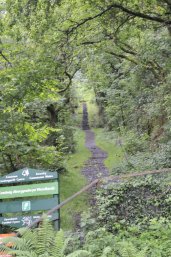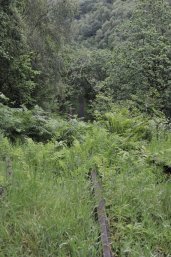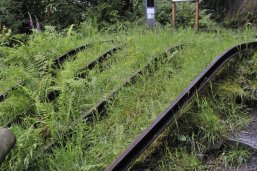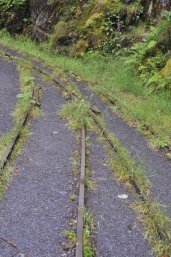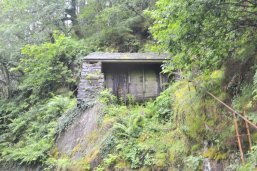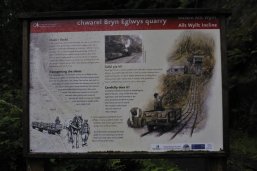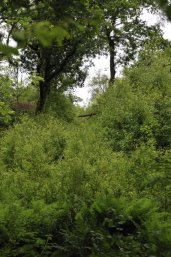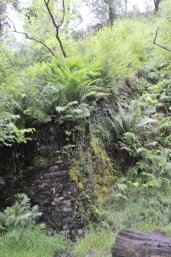Bryn Eglwys Quarry
NGR SH700060 The three inclines (Beudynewydd, Cantrybedd and Alltwyllt) were part of the Bryn Eglwys Quarry System.
The history of the Talyllyn Railway is inextricably tied up with the history of Bryn Eglwys slate quarry. All but invisible from the main valley road, and from the present-day terminus of the Talyllyn Railway at Nant Gwernol, the quarry once employed 300 men and in its time produced 300,000 tons of slate and slabs.
Bryn Eglwys lies on the same veins of slate as the quarries further east around Corris and Aberllefenni. Slate was first quarried at Bryn Eglwys in the 1840s, by John Pughe of Aberdovey, the end product being carried to Aberdovey by pack animals or on carts or sledges for onward shipment by sea.
Curiously, the American Civil War was the real impetus for the construction of a railway to serve the quarry. The Aberdovey Slate Company Limited was formed in 1864 by William McConnell to lease the quarry and open it up on a large scale. McConnell was the owner of a Manchester cotton mill and wished to diversify his interests because of the shortage of raw cotton due to the war in America.
Initially the plan was to build a railway from Bryn Eglwys to Aberdovey, however the construction of the standard-gauge Aberystwyth and Welsh Coast Railway meant that only the section as far as Towyn (as it was then known) was required. Powers to construct a railway from Tywyn to Abergynolwyn, plus a short connecting line at Tywyn which was never built, were obtained in 1865 when Parliament passed the Talyllyn Railway Act. It appears that the railway was in fact already under construction by this time, parliamentary approval being sought as an afterthought to allow the running of passenger services. The reason for the line's name is unclear; Talyllyn Lake is a full 3 1/4 miles from Abergynolwyn, and there has never been any serious intention to extend to this well-known beauty spot. A possible explanation is that the railway would terminate in the parish of Talyllyn.
The engineer was James Swinton Spooner, elder brother of Charles Easton Spooner who had built the Festiniog Railway. Compared to the Festiniog, the Talyllyn was straightforward to build with few earthworks required and a comparatively easy ruling gradient of 1 in 60. Whilst the statutory railway finished just east of the station at Abergynolwyn, the tracks continued over private land into the valley of the Nant Gwernol; passenger trains never (officially) travelled over this "Mineral Extension".
The old watering-point at Ty Dwr, on the mineral extension above Abergynolwyn. The original loco shed was located behind the left-hand slate column
Beyond what is now Nant Gwernol station, the line continued into the hills by a series of rope-worked inclines on which the loaded wagons coming down the hill pulled the empty wagons back up. At Nant Gwernol the line is 270 feet above sea level; the quarries are at almost 700 ft. Beyond the first (Alltwyllt) incline was the half-mile long Galltymoelfre tramway, worked by horses, then the Cantrybedd incline lifted the tracks further to the lowest level of the quarry and eventually, via Beudynewydd incline and a further horse-worked tramway the line reached the main quarry buildings.
Once construction of the line was complete, it was inspected by Captain Henry Tyler of the Board of Trade; his report is dated 25th September 1866. He was unhappy on a number of counts, particularly with the narrow width of the over-bridges which did not leave enough clearance either side of the carriage. This was overcome, resourcefully, by permanently fastening the doors and barring the windows on the side away from the platform, and slewing the track under the bridges. Today bars have gone and the track takes the middle course under the bridges, but the carriages still only have doors on one side. Captain Tyler reported on his reinspection on 8th November and official blessing was given on the 11th for the railway to open. However, an unofficial passenger service appears to have been operating since 1st October.
The rolling stock consisted of two steam locomotives, both built by Fletcher Jennings of Whitehaven but of very different designs; four four-wheeled passenger carriages, three by Brown Marshalls and one by the Lancaster Carriage and Wagon Company; one guard's van by Brown Marshalls; and a reasonable variety of wagons of various sorts (mainly slate wagons). This stock was to suffice until the early 1950s.
The railway never really flourished. By 1879 the quarry had exhausted its funds, and both quarry and railway were offered at auction on 9th October. No buyer was found, nor was one forthcoming at a second auction in March 1881, after which the property was bought personally by William McConnell for £18000. With the company's finances improved, the quarry expanded again, with a large new mill on Cantrybedd level and new underground levels and chambers. William McConnell died in 1902 and the business was taken over by his son, W.H. McConnell. But with the leases on the land running out, there was little incentive to invest and on 17th December 1909 the men were told that the quarry was to close the next day. The remaining stocks were sent down the railway, and the machinery began to be dismantled.
In 1911, however, the recently elected Liberal MP for Merionethshire, Mr. Henry Haydn Jones, bought the railway, quarry and Abergynolwyn village, formed the Abergynolwyn Slate & Slab Co. Ltd. to operate the quarry, and negotiated new leases with the landowners. There was a brief resurgence in business after the First World War, but sales dropped thereafter and the quarry remained open only by cutting away at the pillars separating the underground chambers, a cheap alternative to opening up new chambers and levels. Relations between Haydn Jones and the quarrymen were occasionally strained, and at times the quarry closed for considerable periods or worked only a three-day week.
The grouping of the main-line railways under the 1921 Railways Act passed the Talyllyn by, the adjoining Cambrian Railways line becoming part of the Great Western Railway. Holiday traffic in the summer increased after the First World War, with slate wagons fitted with makeshift wooden seats added to the rear of trains to increase the passenger capacity. With no springs, these provided a bumpy but well-ventilated ride. At times, trains would be run in two portions, running (quite illegally) a short distance apart.
Haydn Jones' leases on the quarry land expired in 1941, though he continued with an annual tenancy. The quarry finally closed following a serious collapse on Boxing Day 1946, the inevitable result of years of "pillaring". After the remaining slate had been brought down, the quarry lay abandoned for several years before the equipment was scrapped. All the buildings on the site have now been demolished, for safety reasons. Visitors should note that Bryn Eglwys quarry is a potentially dangerous place, in particular in the areas of the 1946 collapse and subsequent rock falls, and extreme care must be exercised at all times. Much of the quarry lies on private land.
Despite the decline of Bryneglwys, the Talyllyn Railway soldiered on though becoming more and more decrepit. Sir Haydn had promised that it would continue to operate as long as he was alive, and operate it did although latterly "Talyllyn" was laid off with a very worn boiler and a cracked valve chest, and "Dolgoch" carried on alone after overhaul in Shrewsbury.
By this time the service had been reduced to two trains three days a week, in the summer only. The Talyllyn somehow escaped the nationalisation of railways in 1948, as officialdom thought it too run-down, and the level of traffic too low, to be worth taking over. Derailments were increasingly common and the railway's decline accelerated, culminating in August 1949 with Dolgoch cracking its main frames; this was repaired by welding. Sir Haydn died on 2nd July 1950, and whilst his widow kept the line going until the end of the summer season on 6th October, it then appeared that the railway had closed for good.
But fortunately it was not to be. A group of enthusiasts, led by the engineer and author Tom Rolt, called a public meeting in Birmingham and the Talyllyn Railway Preservation Society was formed. Lady Barbara, Sir Haydn Jones' widow, graciously agreed to let the Society operate the railway, using largely volunteer labour, for a trial period of three years, after which if the experiment was successful the arrangement would become permanent. If the venture failed, Lady Barbara would receive the sum of £1350, which was considered to be the scrap value of the assets. The first passenger trains under Preservation Society auspices ran at the Whit holiday in 1951.
There was a tremendous amount of work to be done. The railway was still operating almost entirely with the original equipment supplied in 1864-66, and locomotives, track and carriages were in a perilous state. The first passenger services ran only as far as Rhydyronen while repairs were carried out on the track east of there, and in the summer a daily service of two trains per day recommenced.
It had been recognised that further motive power was urgently needed, and by good fortune the only two steam locomotives in the country of the correct gauge were located nearby at Machynlleth, redundant since the closure in 1948 of the Corris Railway. The asking price of £65 each was more than the society could afford, but after a visit to Swindon British Railways reduced the price to £50 for the pair. The locos retained their Corris numbers, 3 and 4, and were named "Sir Haydn" and "Edward Thomas" respectively. (Edward Thomas, latterly manager, had joined the railway in 1897 and retired in 1950, though after preservation he remained a director of the company until 1967, by which time he was 87. He died in 1972.)
Another new arrival was an ex-Royal Air Force 0-4-0WT which became No. 6 "Douglas". It was named after the donor, Mr Douglas Abelson of Abelson & Co. (Engineers) Ltd. After regauging from 2' to 2'3" gauge it entered service in 1954. Some work was required before it could start work to lower the track under certain low bridges, as its chimney is taller than any other TR locomotive.
Work on the track was greatly assisted by Territorial Army units which visited the line in 1953 and 1954 and advanced the relaying considerably. Large quantities of second-hand rail were obtained from a variety of industrial sources, and ex-British Rail sleepers were used, sawn in half. The old shale quarry at Quarry Siding was used to provide a rather poor grade of ballast. The last of the wrought iron rail was removed from the main line in 1968, though the work of track maintenance and replacement goes on. (Today Jarrah sleepers from Australia are used, with new or good second hand rails and granite ballast from a nearby quarry.) Another major operation was the repair of a landslip west of Dolgoch, a blocked culvert causing 50 feet of embankment to collapse in November 1957. Whilst temporary repairs to allow trains to pass carefully were completed quickly, it was late 1960 before the job was finished.
In 1957 the BBC visited the railway for live outside broadcasts on two consecutive days. The effect was phenomenal - the number of passengers doubled within two years - but placed a great strain on the railway's resources. Many more carriages had to be built, and more trains run, to cope. Passenger facilities had to be improved as well. Wharf station was extensively improved in 1964-65 (and subsequently), and a new station building at Abergynolwyn providing waiting and refreshment facilities and a booking office replaced the old waiting shelter in 1969.
The original (south) carriage shed at Pendre, was supplemented by the north carriage shed, built between 1959 and 1964, and the newer west carriage shed which was started in 1972. The north shed also incorporates an annexe to the workshop, and the west shed includes a paint shop at its east end. The loco shed was extended in 1968 by incorporating the former cottage, built originally to accommodate the engine driver.
It had always been hoped to open up the former mineral extension for passenger trains. Solicitor and member George Tibbits started work in 1959 on tracing the landowners and negotiating purchase of the land, accomplishing this in 1964. After this it was necessary to obtain a Light Railway Order authorising the construction and operation of the extension, finally issued in 1972.
Construction work, which began on 3rd October 1970, involved a huge amount of widening cuttings, reducing gradients and easing curves, undertaken by the "Gwerns", as the volunteers on the extension became known. The excavated material was used to widen the formation west of Abergynolwyn station to provide for the eventual platform extension and re-sited loop. The railway's 10-RB mechanical excavator "Mr. Rusty" was used latterly to load the rock removed by blasting operations.
As the opening day approached, a final snag was found. An error on the Ordnance Survey maps of the area was found, in the vicinity of "Big Bend" (the final sharp curve which brings the line into Nant Gwernol station). To rectify this problem and maintain the desired 300 foot minimum radius, it would be necessary to remove nearly half as much rock again as had already been excavated. In the end, the line was opened with a 270 foot radius curve, which has become permanent.
The opening ceremony took place on 22nd May 1976, the first train being hauled by a suitably decorated No. 2 "Dolgoch". The guest of honour was the well-known television presenter Wynford Vaughan Thomas. In 1980, a footbridge across the Nant Gwernol ravine was opened giving access to the footpath from Abergynolwyn village. Present and Future The railway has not rested on its laurels since the opening to Nant Gwernol. Maintenance work on track, locos and carriages goes on, and in 1991 the railway's latest steam loco, No. 7 "Tom Rolt", was completed. No. 7 was built at Pendre using components from a loco supplied in 1948 by Andrew Barclay to Bord na Mona (the Irish Turf Board). Construction started in 1971, but with a downturn in traffic after 1973 work ground nearly to a halt for some years. By the late 1980s it was clear that No. 6 "Douglas" would soon need a new boiler, and work on No. 7 recommenced. After years of debate, the name "Tom Rolt" was decided upon, commemorating the driving force behind the railway's preservation. The loco was named on 6th May 1991 by Tom's widow, Sonia.
To accommodate passengers in wheelchairs carriage No. 7 (originally an open carriage from the Penrhyn Quarry Railway, later rebuilt as a tea van before the new Abergynolwyn station was built) was rebuilt as a four-wheeled saloon with wide double doors, all-round glazing, and tip-up seating. It entered service in 1991, and has been followed by the conversion of bogie carriages Nos. 20 and 21 to incorporate a wheelchair saloon at the eastern end.
Safety is of course paramount on a railway such as the Talyllyn. The railway had for many years been exempted from those provisions of the Regulation of Railways Act 1889 which required the provision of continuous automatic brakes, but in recent years air brakes have been fitted to the carriages and air compressors to the locos. Much of the equipment was obtained through contacts with the 2' 6" gauge Puffing Billy Railway in Australia, with which a formal twinning arrangement was made in 1992.
In 2001 the railway celebrates 50 years of operation under the Talyllyn Railway Preservation Society, and a host of special events are planned. It is sobering to consider that the railway has now spent more than a third of its existence under preservation.
Many Thanks to the Talyllyn Railway for some of this info
